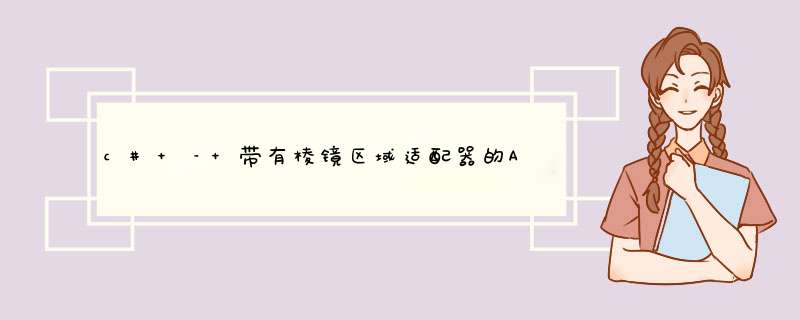
有没有人有关于如何为AvalonDock的LayoutdocumentPane和LayoutAnchorablePane创建Region Adapter的示例代码?
解决方法 不幸的是,据我所知,“LayoutdocumentPane”和“LayoutAnchorablePane”都不允许包含/创建regionadapters,但是“DockingManager”会这样做.一种解决方案是为DockingManager创建regionadapter,然后管理可视树中“Layoutdocuments”的实例化.xaml看起来如下:
<ad:DockingManager Background="AliceBlue" x:name="WorkspaceRegion" prism:RegionManager.Regionname="WorkspaceRegion"> <ad:LayoutRoot> <ad:LayoutPanel> <ad:LayoutdocumentPaneGroup> <ad:LayoutdocumentPane> </ad:LayoutdocumentPane> </ad:LayoutdocumentPaneGroup> </ad:LayoutPanel> </ad:LayoutRoot> </ad:DockingManager>
请注意,该区域在DockingManager标记中定义,并且LayoutPanel下存在一个LayoutdocumentPaneGroup. LayoutdocumentPaneGroup下的LayoutdocumentPane将托管与要添加到“WorkspaceRegion”的视图关联的Layoutdocuments.
至于regionadapter本身,请参考下面的代码,我提供了解释性注释
#region Constructor public AvalonDockregionadapter(IRegionBehaviorFactory factory) : base(factory) { } #endregion //Constructor #region OverrIDes protected overrIDe IRegion CreateRegion() { return new AllActiveRegion(); } protected overrIDe voID Adapt(IRegion region,DockingManager regionTarget) { region.VIEws.CollectionChanged += delegate( Object sender,NotifyCollectionChangedEventArgs e) { this.OnVIEwsCollectionChanged(sender,e,region,regionTarget); }; regionTarget.documentClosed += delegate( Object sender,documentClosedEventArgs e) { this.OndocumentClosedEventArgs(sender,region); }; } #endregion //OverrIDes #region Event Handlers /// <summary> /// Handles the NotifyCollectionChangedEventArgs event. /// </summary> /// <param name="sender">The sender.</param> /// <param name="e">The event.</param> /// <param name="region">The region.</param> /// <param name="regionTarget">The region target.</param> voID OnVIEwsCollectionChanged(object sender,NotifyCollectionChangedEventArgs e,IRegion region,DockingManager regionTarget) { if (e.Action == NotifyCollectionChangedAction.Add) { foreach (FrameworkElement item in e.NewItems) { UIElement vIEw = item as UIElement; if (vIEw != null) { //Create a new layout document to be included in the LayoutDocuemntPane (defined in xaml) Layoutdocument newLayoutdocument = new Layoutdocument(); //Set the content of the Layoutdocument newLayoutdocument.Content = item; viewmodelBase_2 viewmodel = (viewmodelBase_2)item.DataContext; if (viewmodel != null) { //All my viewmodels have propertIEs displayname and IconKey newLayoutdocument.Title = viewmodel.displayname; //GetimageUri is custom made method which gets the icon for the Layoutdocument newLayoutdocument.IconSource = this.GetimageUri(viewmodel.IconKey); } //Store all Layoutdocuments already pertaining to the LayoutdocumentPane (defined in xaml) List<Layoutdocument> oldLayoutdocuments = new List<Layoutdocument>(); //Get the current ILayoutdocumentPane ... Depending on the arrangement of the vIEws this can be either //a simple LayoutdocumentPane or a LayoutdocumentPaneGroup ILayoutdocumentPane currentILayoutdocumentPane = (ILayoutdocumentPane)regionTarget.Layout.RootPanel.Children[0]; if (currentILayoutdocumentPane.GetType() == typeof(LayoutdocumentPaneGroup)) { //If the current ILayoutdocumentPane turns out to be a group //Get the children (Layoutdocuments) of the first pane LayoutdocumentPane oldLayoutdocumentPane = (LayoutdocumentPane)currentILayoutdocumentPane.Children.ToList()[0]; foreach (Layoutdocument child in oldLayoutdocumentPane.Children) { oldLayoutdocuments.Insert(0,child); } } else if (currentILayoutdocumentPane.GetType() == typeof(LayoutdocumentPane)) { //If the current ILayoutdocumentPane turns out to be a simple pane //Get the children (Layoutdocuments) of the single existing pane. foreach (Layoutdocument child in currentILayoutdocumentPane.Children) { oldLayoutdocuments.Insert(0,child); } } //Create a new LayoutdocumentPane and inserts your new Layoutdocument LayoutdocumentPane newLayoutdocumentPane = new LayoutdocumentPane(); newLayoutdocumentPane.InsertChildAt(0,newLayoutdocument); //Append to the new LayoutdocumentPane the old Layoutdocuments foreach (Layoutdocument doc in oldLayoutdocuments) { newLayoutdocumentPane.InsertChildAt(0,doc); } //Traverse the visual tree of the xaml and replace the LayoutdocumentPane (or LayoutdocumentPaneGroup) in xaml //with your new LayoutdocumentPane (or LayoutdocumentPaneGroup) if (currentILayoutdocumentPane.GetType() == typeof(LayoutdocumentPane)) regionTarget.Layout.RootPanel.ReplaceChildAt(0,newLayoutdocumentPane); else if (currentILayoutdocumentPane.GetType() == typeof(LayoutdocumentPaneGroup)) { currentILayoutdocumentPane.ReplaceChild(currentILayoutdocumentPane.Children.ToList()[0],newLayoutdocumentPane); regionTarget.Layout.RootPanel.ReplaceChildAt(0,currentILayoutdocumentPane); } newLayoutdocument.IsActive = true; } } } } /// <summary> /// Handles the documentClosedEventArgs event raised by the DockingNanager when /// one of the LayoutContent it hosts is closed. /// </summary> /// <param name="sender">The sender</param> /// <param name="e">The event.</param> /// <param name="region">The region.</param> voID OndocumentClosedEventArgs(object sender,documentClosedEventArgs e,IRegion region) { region.Remove(e.document.Content); } #endregion //Event handlers 不要忘记在bootstrapper中添加以下代码,以便Prism知道regionadapter的存在
protected overrIDe regionadapterMapPings ConfigureregionadapterMapPings() { // Call base method var mapPings = base.ConfigureregionadapterMapPings(); if (mapPings == null) return null; // Add custom mapPings mapPings.RegisterMapPing(typeof(DockingManager),ServiceLocator.Current.GetInstance<AvalonDockregionadapter>()); // Set return value return mapPings; } 瞧.我知道这不是最干净的解决方案,但应该有效.同样的方法可以很容易地应用于“LayoutAnchorablePane”.
健康长寿·繁荣昌盛!
总结以上是内存溢出为你收集整理的c# – 带有棱镜区域适配器的AvalonDock全部内容,希望文章能够帮你解决c# – 带有棱镜区域适配器的AvalonDock所遇到的程序开发问题。
如果觉得内存溢出网站内容还不错,欢迎将内存溢出网站推荐给程序员好友。
欢迎分享,转载请注明来源:内存溢出

 微信扫一扫
微信扫一扫
 支付宝扫一扫
支付宝扫一扫
评论列表(0条)